
Insurgentes is a station on the Line 1 of Mexico City Metro. It is located within the Glorieta de los Insurgentes at the intersection of Avenida de los Insurgentes and Avenida Chapultepec in Mexico City's Cuauhtémoc borough, close to the Zona Rosa shopping and entertainment district and the Colonia Roma, two of the most iconic neighborhoods in the city. In 2019, the station had an average ridership of 65,134 passengers per day, making it the 12th busiest station in the network. Since 9 November 2023, the station has remained closed for modernization work on the tunnel and the line's technical equipment.

Zaragoza metro station is a station of the Mexico City Metro in Venustiano Carranza, Mexico City. It is an underground station with two side platforms served by Line 1 between Gómez Farías and Pantitlán stations. It serves the colonias (neighborhoods) of 4 Árboles and Puebla. It lies below the Calzada Ignacio Zaragoza from which it receives its name, which in turn is named after Ignacio Zaragoza, the Secretary of War and Navy during the Battle of Puebla. The station's pictogram features a silhouette of the nearby equestrian statue that honors him.

Aragón metro station is a Mexico City Metro station within the limits of Gustavo A. Madero and Venustiano Carranza, in Mexico City. It is an at-grade station with one island platform, served by Line 5, between Eduardo Molina and Oceanía stations. Aragón station serves the colonias of Casas Alemán and Simón Bolívar. The station is named after the San Juan de Aragón Park, and its pictogram represents the silhouette of a squirrel. Aragón metro station was opened on 19 December 1981, on the first day of the Consulado–Pantitlán service. In 2019, the station had an average daily ridership of 7,547 passengers, making it the 172nd busiest station in the network and the eighth busiest of the line.

Buenavista is a station on the Mexico City Metro, in the Colonia Buenavista neighborhood of the Cuauhtémoc borough. It is the southwestern terminal station of Line B. It also offers connections to the Insurgentes Metrobús bus rapid transit line. In 2019, the station had an average ridership of 66,804 passengers per day, making it the tenth busiest station in the network.

Balbuena metro station is a station of the Mexico City Metro in Venustiano Carranza, Mexico City. It is an underground station with two side platforms served by Line 1 between Moctezuma and Boulevard Puerto Aéreo stations. It serves the colonias (neighborhoods) of Jardín Balbuena and Moctezuma 1ª sección, along Calzada Ignacio Zaragoza. The station's pictogram features the silhouette of four flowers with four petals each, in reference to the Balbuena Garden, found in the neighborhood of the same name, and from which the station takes its name.
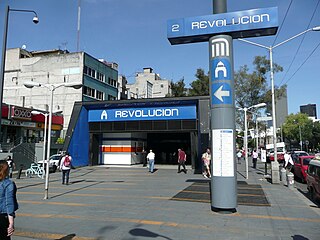
Revolución is a station on Line 2 of the Mexico City Metro system. It is located in the Colonia Tabacalera and Colonia Buenavista districts in the Cuauhtémoc borough of Mexico City, northwest of the city centre, on Avenida México - Tenochtitlan. It was first opened to the public on 14 September 1970.
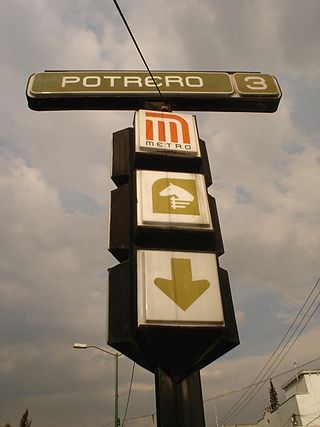
Potrero metro station is a station of the Mexico City Metro built along Insurgentes Norte Avenue in the colonias (neighborhoods) of Capultitlan and Guadalupe Insurgentes, in Gustavo A. Madero, Mexico City. It is an at-grade station with one island platform served by Line 3 between Deportivo 18 de Marzo and La Raza stations. The station and its surrounding area are named this way because there used to be a hippodrome during the Porfiriato era (1876–1911) and its pictogram features the silhouette of a head of a horse behind a fence. The station was opened on 1 December 1979, on the first day of service between Indios Verdes and Hospital General metro stations.

Canal del Norte is a station on the Mexico City Metro. It is located in the Venustiano Carranza borough, in the north of Mexico City.

Politécnico metro station is a Mexico City Metro station in Gustavo A. Madero, Mexico City. It is an at-grade station with two side platforms that serves as the northern terminus of Line 5. It is followed by Instituto del Petróleo station. Politécnico station serves the colonias (neighborhoods) of Industrial Vallejo and Nueva Industrial Vallejo. The station's pictogram features the logo of the National Polytechnic Institute (IPN), a public university in Mexico City, and its name is on account of its proximity to the main campus.
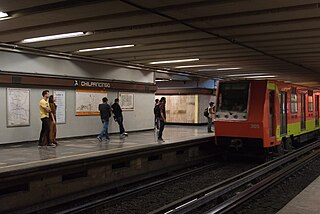
Chilpancingo is an underground metro station along Line 9 of the Mexico City Metro. It is located in the Cuauhtémoc borough of Mexico City. It is very close to Metrobús station of the same name. In 2019, the station had an average ridership of 49,122 passengers per day, making it the busiest station in Line 9 and the 17th busiest station in the network.
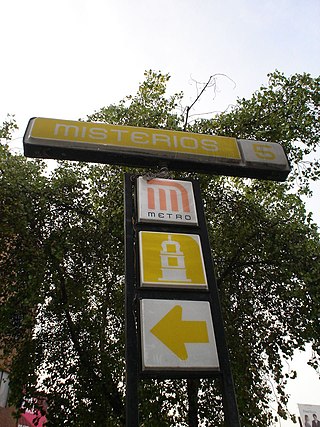
Misterios metro station is a Mexico City Metro station within the limits of Cuauhtémoc and Gustavo A. Madero, in Mexico City. It is an underground station with two side platforms, served by Line 5, between La Raza and Valle Gómez stations. Misterios station serves the colonias (neighborhoods) of Peralvillo and Vallejo.
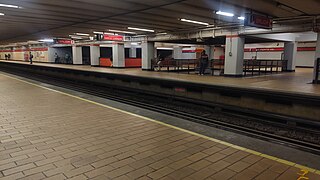
Norte 45 is a station on Line 6 of the Mexico City Metro. It is located in the Colonia Pueblo Salinas neighborhood.
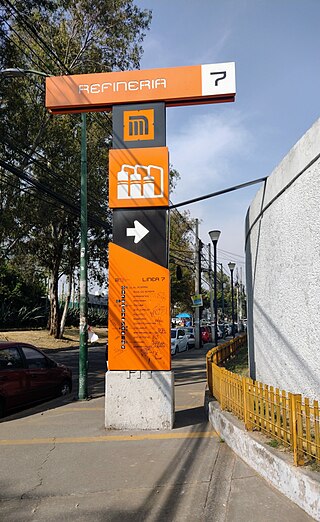
Refinería is a station along Line 7 of the metro of Mexico City. The station is located close to the Pemex 18 de marzo refinery in the Colonia Ángel Zimbrón neighborhood of the Azcapotzalco borough northwest of the city center, between the stations of Camarones and Tacuba. Its logo represents three containers of the Pemex refinery.
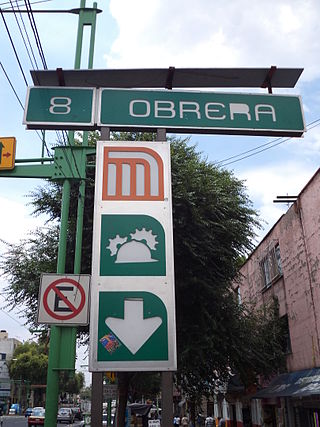
Obrera is a station along Line 8 of the metro of Mexico City. The station is situated on Eje Central Lázaro Cárdenas. The station's logo is a construction worker's helmet framed with two gears. The name obrera comes from the Colonia Obrera neighborhood where the station is located.

Agrícola Oriental is a metro station on Line A of the Mexico City Metro system. It is located in the Iztacalco municipality. In 2019, the station had an average ridership of 11,317 passengers per day, making it the least used station in Line A.

Canal de San Juan is a station along Line A of the Mexico City Metro. It is located in the Iztacalco municipality. In 2019, the station had an average ridership of 13,188 passengers per day.
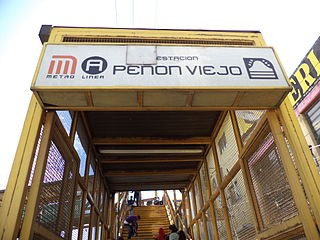
Peñon Viejo is a station along Line A of the Mexico City Metro. It is located in the Colonia Santa Martha Acatitla Norte and Colonia Santa Martha Acatitla Sur neighborhoods of the Iztapalapa borough of Mexico City.

Tláhuac metro station is a station of the Mexico City Metro in the colonia of El Triángulo, Tláhuac, Mexico City. It is an at-grade station with two island platforms that serves as the southern terminus of Line 12. The station's pictogram features the glyph of Tláhuac. It is followed by Tlaltenco station, in the same borough. The station was opened on 30 October 2012, on the first day of the service Tláhuac–Mixcoac.
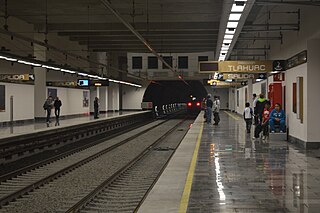
Eje Central is a station on Line 12 of the Mexico City Metro. The station is located between Parque de los Venados and Ermita. It was opened on 30 October 2012 as a part of the first stretch of Line 12 between Mixcoac and Tláhuac.

La Paz is a Mexico City Metro station that serves Line A. It is the line's terminal station. It opened, along with the other stations along Line A, on 12 August 1991. It is located in Los Reyes Acaquilpan, State of Mexico – a city that is the municipal seat of the La Paz municipality.

























